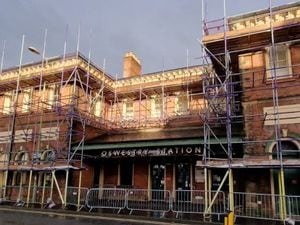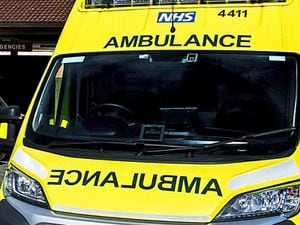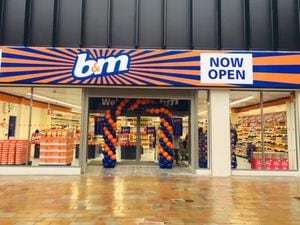June 6, 1944. A day brave heroes will never forget
June 6, 1944. A day of heroes whose legacy is today's peaceful Europe in which no citizen lives under the jackboot. They are a dwindling bunch, with time the great enemy now writes Toby Neal.
Some did not live to step foot on the Normandy beaches, perishing through mines or gunfire in their landing craft or drowning in the water. Many did not survive to see the night of that dramatic first day of the liberation of Europe.
Men of the Shropshire regiment were to distinguish themselves on that epic day. Soldiers of the 2nd Battalion of the King's Shropshire Light Infantry landed on Sword beach near Hermanville shortly after 10am and their job was to advance inland on the back of Sherman tanks of the Staffordshire Yeomanry. But with there being a logjam on the invasion beaches, the tanks did not turn up.
So the Shropshires walked, following the D60 road. At 5.30pm Major Peter Steel's Company had reached Lebisey, north of Caen. However, the Shropshires had advanced so far that they were out on a limb, and had to withdraw. Sadly Major Steel was killed by a machinegun bullet at Lebisey.
He was one of 113 officers and men of the battalion killed or wounded on D-Day - roughly one in seven. The commander, Lieutenant Colonel Jack Maurice, was awarded the Distinguished Service Order, but was himself killed by shellfire on July 6.
In May 2004 a handful of surviving 2KSLI veterans, along with family and friends, attended the dedication of a memorial at Lebisey erected in honour of their achievement to mark the 60th anniversary of D-Day.
The old soldiers were feted by a grateful and respectful modern generation, and, a stone memorial was unveiled reading: "In Honour of the Second Battalion Kings Shropshire Light Infantry who liberated Bieville – Beuville and immediately attacked Lebisey on the afternoon of June 6 1944."
The ceremony was the successful conclusion of a three-year campaign by John Eaves, who on D-Day was the intelligence officer of the battalion.
Like so many veterans, Mr Eaves, who was wounded in the arm by shrapnel on D-Day+2, and much more seriously by a mortar bomb on October 16, 1944, is no longer with us, having died nearly six years ago. So far as his widow is aware, there are just two of that party of 10 veterans of 2KSLI who are still alive, Desmond Abraham, who lives near Aberystwyth, and Geoffrey Litherland, from Hampshire.
The exploits of the Shropshire regiment were just one element of the involvement of Salopians in the land, sea, and air operation.
For air gunner Wilfred Hughes of Shrewsbury, the D-Day operation was just another "op" rating a brief mention in his logbook.
Billy Hughes - that was how he was known to his crewmates - was the rear turret gunner in a troop-carrying Short Stirling aircraft from 620 Squadron which dropped two sticks of paratroops in the Ranville area as the invasion began.
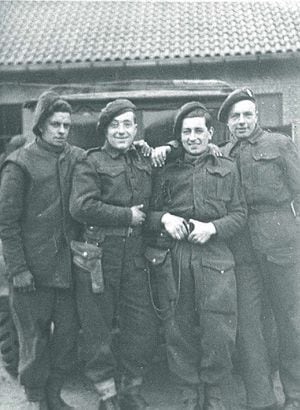
"Ops D-Day" is the simple description of the four-hour flight in his logbook. He had been married only a few weeks before, at Broseley, to a local girl.
Flight Sergeant Hughes, who was 20, was destined never to be able to tell grandchildren what he did in the war. He died along with his crew when they were shot down over Norway on December 28, 1944.
Bill Weaver, of Shawbirch, one of the heroes still among us, went ashore under fire in the first wave of the operation in an amphibious vehicle called a Dukw, or "Duck".
"At 6.30am the bow doors were opened and we seven Dukws from F Platoon, 705 Company prepared to launch as we were to make the five or six miles to shore under our own power.
"Through the doors we could see the French coast and the great array of ships of every size and shape around us. Around the ramp off the Press started to gather. Cameras were flashing as we moved down the ramp. I've never seen a photograph that was taken. My Dukw was F33, crew Bill Weston and myself. We also had on board our 2 I/C. Captain Goodhew and a dozen infantry men of the Hampshire Regiment.
"Our destination was Jig/Green on Gold Beach. The shells passing over us on the way to the shore defences and the rocket ships firing closer to shore was deafening.
"As we got nearer the shore the shells and bullets started to come our way but by this time we were too busy trying to avoid the mined hedgehog shore defences which began to appear between the rollers."
Fred Williams of Whitchurch was a gunner in the third tank ashore at St Aubin-sur-Mer on Juno Beach.
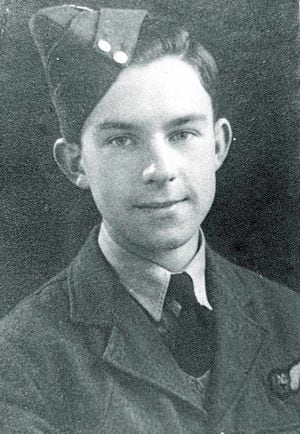
Speaking on the 60th anniversary in 2004, he recalled looking towards the Normandy beaches in the gathering daylight and seeing a frightening array of obstacles and guns awaiting the invading force.
"There were shells, mortars, machine guns. Of course, they were mowing the infantry down. We were inside the tank and never got hit that day."
Not everyone involved in the operation was in the armed forces. Alan Wellington, who is 88, was a teenage veteran of the Battle of the Atlantic when he was sent to the invasion beaches to take in American troops.
He had only turned 19 just over three weeks beforehand. In those days his home was Rose Cottage, Nobold, but he lives now at Meole Crescent, Shrewsbury.
"My part in the D-Day landings was rather brief. As a junior Merchant Navy officer, I had just arrived back in the UK from hospital in Port Said, Egypt (he had had suspected appendicitis). I was then assigned to the 'City of Canterbury' in Glasgow, to an unknown destination.
"As I recall, we sailed down the coast and eventually dropped anchor somewhere along the south coast. It was dark by then and our orders were to stay at anchor.
"We were then surrounded by landing craft carrying American troops. The landing craft and troops were then loaded onto our ship, and within no time we were heading for the Channel and the Omaha beachhead."
Mr Wellington, who was the assistant troop deck officer, continued: "The crossing was ghostly quiet among the troops. These were backup troops on day two, and we all know what a battle the Americans had on day one. The film Saving Private Ryan told that story.
"However, our job was to take them as near to the beachhead as was allowed. We saw areas lit up by flares and flashes of gunfire and felt relieved that we were getting out of there. But those brave men were heading straight into battle. They couldn't turn back. Their orders would be to kill or be killed."
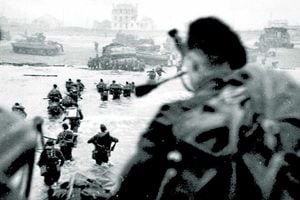
Of all the desirable qualities among fighting men, the most desirable of all was perhaps not stamina or skill, but a healthy dose of good luck.
Ernie Goodman, of the Second Battalion of the King's Shropshire Light Infantry, was one of the lucky ones. Speaking in 2004, he said: "I was scared stiff. I think most people were."
His wartime role was driving the carrier which towed a 6-pounder anti-tank gun. While the D-Day landings went well, a few weeks later all his gun team with the exception of himself were killed or wounded. "A shell hit an apple tree above their trench and the blast went straight down and killed two of them and injured the other. The next night they jumped in this trench thinking the same thing would never happen in the same place. And it did. I was the only one left."
Crossword clues blew cover for top secret code
Omaha, Utah, Mulberry, Neptune, Overlord...
Any military historian worth his or her salt will know immediately the full significance of those words.
They were, of course, crossword answers in the Daily Telegraph. And they appeared in the weeks before D-Day, blowing the cover for the top secret code words used by the Allies for some of the invasion beaches, the specially-made artificial harbours, and also, in Overlord, for the entire operation on which the outcome of the war depended.
It is not surprising that the crossword compiler, a Surrey teacher named Leonard Dawe, was arrested and interrogated as a possible spy by M15. The Daily Telegraph crossword already had form, having used "Dieppe" as an answer only days before the ill-fated Dieppe raid in 1942.
Dawe persuaded his questioners of his innocence. No action was taken and it was put down as an extraordinary coincidence.
But research by Ironbridge crossword compiler Roger Squires has pointed to the real culprit being a 14-year-old schoolboy from Wolverhampton.
Ronald French's school had been evacuated to Effingham in Surrey, near to several American camps, and Ronald picked up the codewords from the soldiers.
Dawe had the habit of inviting pupils under detention to spend their time filling in the crossword grids for which he later provided the clues.
In that way, the codewords young Ronald had picked up found their way into the Daily Telegraph.
After MI5 had departed, Dawe called Ronald in, discovered the source of the words and, after confiscating and burning his notebooks, made Ronald swear on the Bible that he would not divulge to anyone what had occurred.
However, it seems that Ronald was also interrogated, but that the authorities decided in the end that it was an innocent matter.
As for the story of the beaches, Gold, was at the centre of the landing zones halfway between the Cotentin peninsula and the River Orne and near Asnelles. The British 50th (Northumbrian) Infantry Division overcame stiff German resistance to establish a secure bridgehead.
Sword was the target for the 3rd British Infantry Division and among those landing was the Second Battalion of the King's Shropshire Light Infantry.
To the British, Juno is less well known, because this was a Canadian show. At 8am, the first men of the 50th Canadian Infantry Division landed between Gray-sur-Mer and Bernieres-sur-Mer and forged a seven-mile long bridgehead.
Events at Omaha Beach were dramatised in the Steven Spielberg film Saving Private Ryan which accurately depicted American troops being mown down by murderous fire. Over 2,000 Americans were killed or wounded in landings which came close to failure.
At Utah, in what turned out to be a stroke of luck, American forces landed further south than intended, where defences were much lighter.
Adapting to the situation, Brigadier General Theodore Roosevelt famously said: "We'll start the war from right here!"
Most famous message never sent
"Our landings in the Cherbourg-Havre area have failed to gain a satisfactory foothold and I have withdrawn the troops."
It has to be one of the most famous messages never sent.
It had been drafted by General Dwight D. Eisenhower on the eve of D-Day.
The handwritten note continued: "My decision to attack at this time and place was based on the best information available. The troops, the air and the navy did all that bravery and devotion to duty could do. If any blame or fault attaches to the attempt it is mine alone."
In the drama of the moment he accidentally dated it July 5. By the time Eisenhower came across the forgotten note tucked inside his wallet, on July 11, 1944, the course of history had been altered forever. The invasion of Normandy had been a spectacular success and, while there was much hard fighting to come, there was now an irreversible momentum which made the downfall of Hitler's Germany a matter of timing.
Eisenhower's fears were fully justified.
A large scale raid on the French port of Dieppe in August 1942 had been a bloody disaster. The Salerno landing in 1943 had nearly been beaten back into the sea. A landing at Anzio in January 1944 achieved complete surprise but the landing forces were bottled up for months.
However through bitter experience lessons had been learned.
And then there was the trump card for the attacking forces - the weather.
High wind, rain, and the sea state in the English Channel had already led to a postponement and if the bad weather persisted it would be many days before a suitable combination of conditions came again.
The German defenders took it for granted that there would be no landings until the weather improved. And so it was that Rommel, in charge of the defences, was on leave in Germany celebrating his wife's birthday when the D-Day operation began.
What Allied forecasters had spotted was that there was an oasis of calm on the way - although the sea would still be a bit choppy and low cloud would hamper air operations.
Eisenhower took that risk, seized the opportunity and gave the go ahead.
Thanks in part to a highly successful deception operation, the German defenders had expected the blow to fall in the Pas de Calais, which would have given the Allies a much shorter crossing and a shorter and more direct route to Germany. It was here, around Calais, that the heaviest defences were concentrated.
In contrast, in Normandy defence work was incomplete by D-Day. Even after the landings, the German high command was so convinced that the Normandy operation was a feint that they held back vital tank units in the Calais area for weeks. By the time they were deployed, it was too late to turn the tide.
The first the Germans knew that something was afoot was reports of airborne troops coming down over a widely dispersed area of Normandy in the early hours of D-Day. Many were landing miles from their intended destinations, which only added to the confusion of the defenders.
The German forces had been caught on the hop. They were never to recover that lost initiative.

